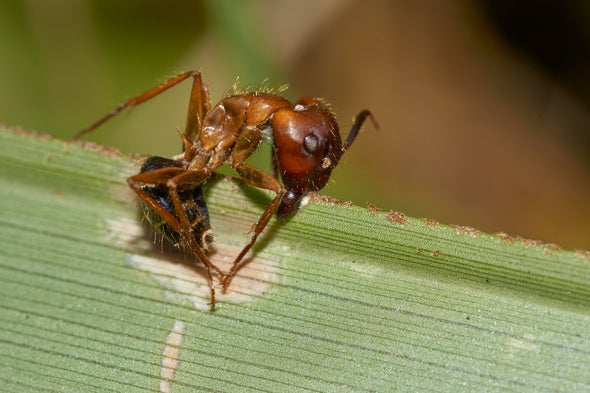(单词翻译:单击)
听力文本
This is Scientific American's 60-second Science, I'm Christopher Intagliata.
It's straight out of a horror movie: an ant, infected with a fungus, starts behaving strangely. It crawls as high as it can in the forest, grabs a leaf or twig in its mouth and bites. Hard.
"It enters into this 'death-grip phenotype' is what we call it." Colleen Mangold, a molecular biologist at Penn State. "And then a couple hours after initiation of that behavior the ant will die."
The fungus, known as Ophiocordyceps, then eats through the corpse and sprouts a stalk from the ant's body to release more spores and infect more ants. It's a harsh way to go.
"It's not ideal, definitely not ideal."
Mangold and her colleagues wanted to get to the bottom of why the ants do this—specifically, how they get their death grip. So they dissected infected ants and zoomed in on their jaw muscles with electron microscopes.

They saw that the fungus had invaded and grown into jaw muscle cells, perhaps to suck up nutrients. And they spotted lots of mysterious tiny particles, which might be produced by the ant's immune system—or by the fungus, as a way of communicating with the muscle and forcing it to contract.
Whatever the mechanism, they found that the ant's jaw muscles had contracted so hard, they'd been irreparably damaged. The full details—and gory pictures—are in the Journal of Experimental Biology.
Mangold hopes to get to the bottom of what those tiny particles do in follow-up work. And in the meantime, unless you're a carpenter ant, rest assured you have nothing to worry about.
"It's highly species specific. I seriously doubt we'll be seeing any real-life human zombies anytime soon."
Thanks for listening for Scientific American — 60-Second Science. I'm Christopher Intagliata.
参考译文
这里是科学美国人——60秒科学系列,我是克里斯托弗·因塔格里塔。
这就像恐怖电影里的场景:一只蚂蚁在感染真菌后,开始变得行为怪异。它尽其所能地爬到森林高处,用嘴含住一片树叶或一根树枝,然后咬着。很困难。
“它进入了我们称之为的‘死亡之握表现型’。”宾夕法尼亚州立大学的分子生物学家科琳·曼戈尔德说到。“这种行为持续几个小时后,蚂蚁就会死亡。”
这种名为“线虫草属”的真菌,会吃掉蚂蚁的尸体,然后从蚂蚁体内长出一根茎,释放更多孢子,感染更多蚂蚁。真是种残酷的手段。
“这不是理想,绝对不是。”
曼戈尔德和同事想弄清楚蚂蚁为何会这样做,特别是它们是如何到达“死亡一握”状态的。因此,他们解剖了受感染的蚂蚁,并用电子显微镜放大了它们的颚肌。
他们发现,真菌已经侵入并在颚肌细胞中成长,可能是为了吸收营养。他们找到了许多神秘的微小颗粒,这些颗粒可能是蚂蚁免疫系统产生的,或者是真菌产生的,作为与肌肉连通并迫使肌肉收缩的方式。
无论机制为何,他们发现,蚂蚁颚肌收缩得非常严重,已经受到了不可挽回的损伤。完整细节以及血淋淋的图片刊登在《实验生物学杂志》上。
曼戈尔德希望在后续研究中弄清这些微小颗粒的作用。与此同时,除非你是一只木匠蚁,那你可以放心,没什么可担心的。
“这是高度物种特异性。我严重怀疑我们不久后就能看到现实生活中的人类僵尸。”
谢谢大家收听科学美国人——60秒科学。我是克里斯托弗·因塔利亚塔。
译文为可可英语翻译,未经授权请勿转载!
重点讲解
重点讲解:
1. get to the bottom of 找到…的真正起因;查寻到…的根源;
I have to get to the bottom of this mess.
我必须查清造成这一混乱局面的真正原因。
2. zoom in on (摄像机或摄影机)拉近镜头,进行近景拍摄;
The camera zoomed in on the actor's face.
摄影机将演员的脸拉近了。
3. in the meantime 在此期间;其间;
In the meantime the war of nerves seems likely to continue.
与此同时,心理战似乎还可能继续。
4. rest assured 可以放心;可以安心;
Their parents can rest assured that their children's safety will be of paramount importance.
家长尽可放心,孩子们的安全将成为重中之重。


